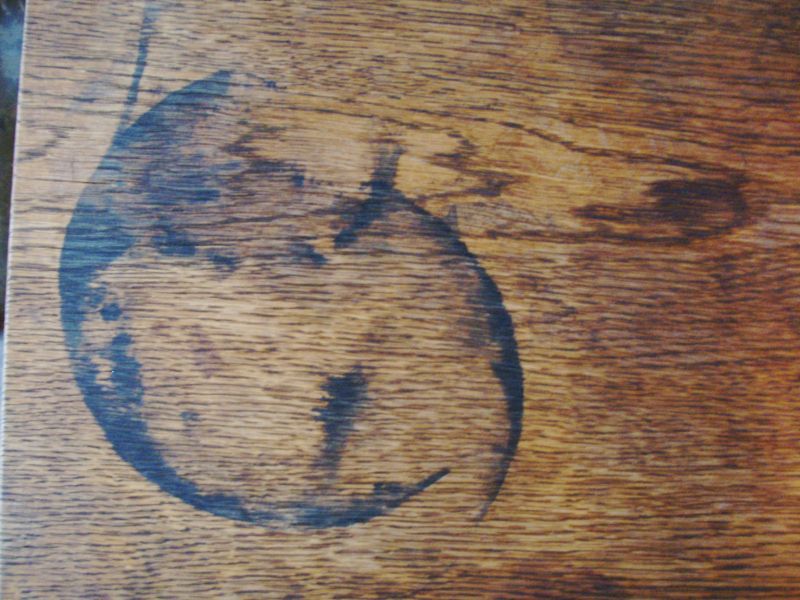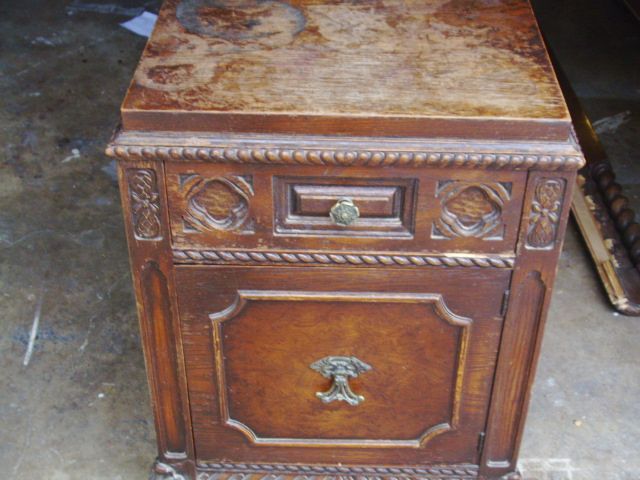Removing Black Stains from Oak
Other Versions
Spanish
French
Advice on getting water stains out of Oak. January 24, 2010
Question
How can I get this black stain out of this oak veneer top? It is an antique piece so there is no telling what it is or how long it's been there. I have washed it with lacquer thinner and steel wool. I then sanded it as much as I dared and I fear it is all the way through. Maybe oxalic acid? Two part bleach? Help!

Click here for higher quality, full size image
Forum Responses
(Finishing Forum)
From contributor S:
What actually happens is the tannins in the oak react with the water and chemically change the wood. I have never (35+ years) found an answer and have simply accepted the fact that sometimes you cannot change the laws of chemistry. Bleach doesn't work, you can't sand it out and there are just times when you have to go to the client and say "I can't do it, mortifying as it may be." Mostly folks get it.
From contributor A:
See this article:
Bleaching Water Stains Out of Oak
From the original questioner:
Thanks! That was helpful.
From contributor C:
You could use art pencils to cover it. Mohawk blending sticks. It takes a little practice and I find it works best if I blend it out a long way, sometimes over the whole top.
From contributor K:
I'd be surprised if oxalic acid didn't get most of the stain out. Just be sure to rinse well and wear a dusk mask when sanding and don't sand any more than necessary or you will bring the stain back up.
From contributor D:
I have used both with good results. For a stain such as yours, either method will require a few applications to remove the stain to your liking.
One note: 2 part bleach may bring the treated area to a lighter color than the wood itself, which will require you to tone the area up to the same color.
From contributor T:
I assume the oxalic acid worked for you. Just want to suggest not to use steel wool and water on raw wood, especially white oak. Any little shreds of wet steel wool on the white oak will make little black spots (like distressing) and you will have to use oxalic acid again. Nylon scrubbing pads (ScotchBrite) would be appropriate.
From the original questioner:
I have not tried oxalic acid yet because I wanted to wait a little so I could read all postings. I will try tomorrow if I can find any on a Sunday. Thanks for the tip about the steel wool and water. It makes perfect sense but it would not have occurred to me if you had not mentioned it.
How should I refinish the top to as closely as possible recreate the finish that was applied to the furniture in 1928? The piece shown in the photo is just the nightstand to a five piece bedroom suite that I am restoring. I can't really tell if it is lacquer or varnish. Maybe shellac? I dunno. My inclination is to finish the top with pre-cat lacquer followed by pumice and rottenstone rubs. The rest of the piece is in better condition and I don't want to alter the original finish any more than I have to and still make it look immaculate. What do professional restorers do in a case like this? One guy on an antiques forum said to use tung oil. Really?

Click here for higher quality, full size image
From contributor L:
I would try the oxalic acid. It will likely lighten it. Then if the top needs to match the rest of the piece, I would use the Mohawk Blendal sticks to color the dark area.
From contributor N:
Test for shellac by swabbing a little denatured alcohol on an obscure part of the existing finish. If it gets tacky in a few seconds, shellac. The photo looks like a film finish of some sort has been applied. I'd steer clear of the tung oil; "antiques" people mention it almost by reflex. Clean the parts you don't want to alter with mineral spirits or VM&P and short bristle brushes (get the whitish buildup out of the carving). Rag the slop before it dries. Touch in bare spots, rubs, etc. Use one of the round shoe brushes to push a dark colored paste wax into the crevices and a cheese cloth pad to wax the flats. Burnish with a shoe buffing brush and rags.
From contributor R:
Oxalic acid works wonders on stains just like the one in your picture. I would mix up a saturated solution of oxalic acid in very hot water and apply it to the raw wood with a cheapo toss out brush. The oxalic acid will work even better if you can place the piece you're bleaching in direct sunlight. Oxalic acid won't penetrate a finish, so be sure the piece you're bleaching is absolutely free of any finish. You can apply another coat of the oxalic acid right over the dried crystals if needed. Once you're happy with the results, wash off the crystals with hot water and let the piece you're bleaching dry.
As far as sanding goes, the veneers of yesteryear are about twice as thick as the veneers of today, so you may be able to sand the surface a bit more aggressively than you would normally sand a veneer. 150 is a good grit to start with. Once you've bleached and sanded, if you find the stain beyond touching up, re-veneering is another option you could consider.

